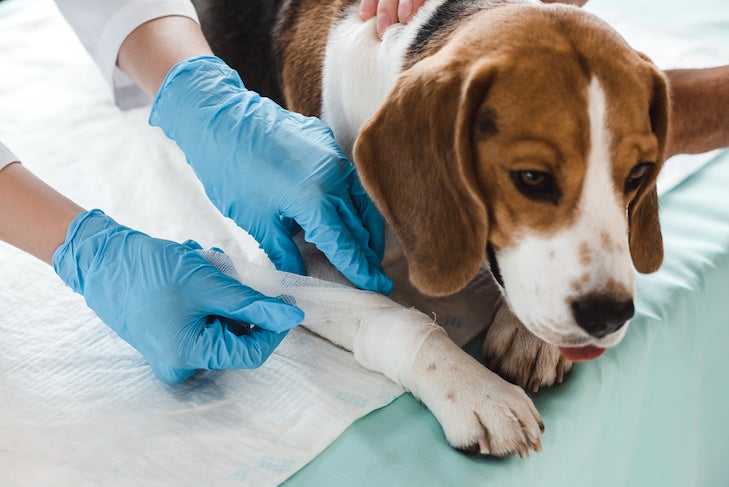
As an emergency veterinarian for over thirty years, one of the most common reasons dogs visited my hospital was because of a bite wound by another dog. The bite wound may have been caused by another family dog or by a fight with an unfamiliar dog.
Biting is often part of aggressive play in puppies but in adult dogs, biting or other aggressive behaviors can have multiple underlying motives or causes. Aggressive behaviors such as growling, and biting are used as a means of communication and to resolve competitive issues or perceived threats. There may be competition over food, territory, attention of an owner, position in a pack or group, fear, or a protective reaction towards another dog.
How serious are dog bite wounds?
Dog bites can cause significant injury to the skin and soft tissues. The dog’s teeth and jaws are very powerful and cause punctures, and in some cases cause a shearing effect when the victim is shaken. Think of a bite wound as an iceberg where most of the damage may often be under the surface. Depending on the location of the wounds, tissues can be torn or crushed. The most concerning wounds are ones that penetrate the chest and the abdomen as they can cause serious internal and potentially life-threatening damage. Even a bite that does not break the skin can cause crushing or bruising injuries to the underlying soft tissues.
Wounds on the head can injure the eyes, ears, and facial nerves. Wounds on the neck can potentially damage major blood vessels or the trachea. Bite wounds on the legs can pierce joints.
Does my dog need to be seen by the veterinarian after it has been in a fight?
If a dog has been involved in a fight, it is always recommended to have the dog see a veterinarian as soon as possible. Particularly within 6 hours after the incident, as the chance of infection is known to lessen when wounds are immediately treated. Owners sometimes don’t realize the number or extent of wounds, as they can be hidden by fur. A simple clue: bite wounds usually come in pairs. Always look out for a second or multiple wounds.
Wounds that appear to be minor on the surface can be deceptive and may have the potential to be life threatening. Punctures to the chest or abdomen can be fatal.
A dog’s mouth is full of bacteria, and as a result any bite that punctures the skin will introduce bacteria or other infectious organisms below the skin surface.
This can cause bacteria to multiply and spread throughout the underlying tissues. Therefore, all bite wounds are considered contaminated and/or infected. Left untreated, skin may heal rather quickly but the bacteria will remain inside the healed skin and an infected bite wound will cause an abscess (a closed pocket of bacteria and pus) or a more generalized cellulitis. In some cases, the infection can get into the blood stream causing life threatening sepsis.
What sort of treatment will be given to my dog?
Your veterinarian will determine what sort of treatment is necessary, based on the extent of the injuries, your dog’s general health, and the location of the wounds. The goal of treatment is to reduce the severity of any infection that develops. This will be often accomplished by clipping the affected area to better visualize the wounds and thoroughly cleaning the wounds. Removal of any dead or severely damaged tissue may also be performed.
Small puncture wounds will usually not be sutured closed and are left open so that any infection can drain out. Some lacerations may be sutured up and temporary drains may be placed if the damage is extensive, or if there is an underlying pocket of space that fluid will build up in the area.
Wounds that penetrate the chest or abdomen will need more extensive care. Radiographs and possibly surgical exploration of a penetrated abdomen may be needed to inspect the integrity or damage of vital organs.
Antibiotics are usually prescribed for wounds that have penetrated the skin depending on the location of the wound and the duration between bite time and presentation to your veterinarian. Pain medication will also often be prescribed such as non-steroidal anti-inflammatory drugs.
Home care
Your veterinarian will give you specific instructions on the use of medications prescribed for your dog. They may want to re-check your dog in several days to be certain things are going well. To prevent your dog from excessively licking wounds or affected areas, an Elizabethan collar will often be placed on your dog prior to going home. You should leave the collar on until your veterinarian instructs you to remove it.
You should be observant if your dog’s wounds have been closed with sutures, because you will need to keep the area clean and dry. If the wound has been left open to heal, or if a drain was placed in the wound, you may need to clean away any draining material on a regular basis using a cleanser. Use only products that are recommended by your veterinarian. Notify your veterinarian if the wounds appear to worsen (swelling, redness, pustular discharge).
What can I do to prevent bite wounds?
Prevention of bite wounds would involve not allowing your dog to roam freely and keeping your dog on a tight leash when you are outdoors, especially if you are in a park. Be alert when dogs are playing with toys or are eating in a group. Dog wounds can occur in an instant; even under the best cautious care. Since you have no way of knowing the health status or vaccine record of the other dog, especially if it is a stray, you must protect your dog. Therefore, you should make sure your dog’s rabies vaccine is always up to date.

